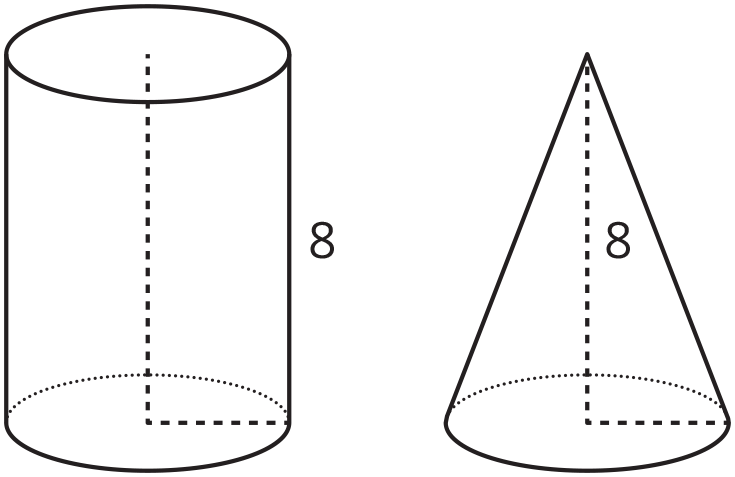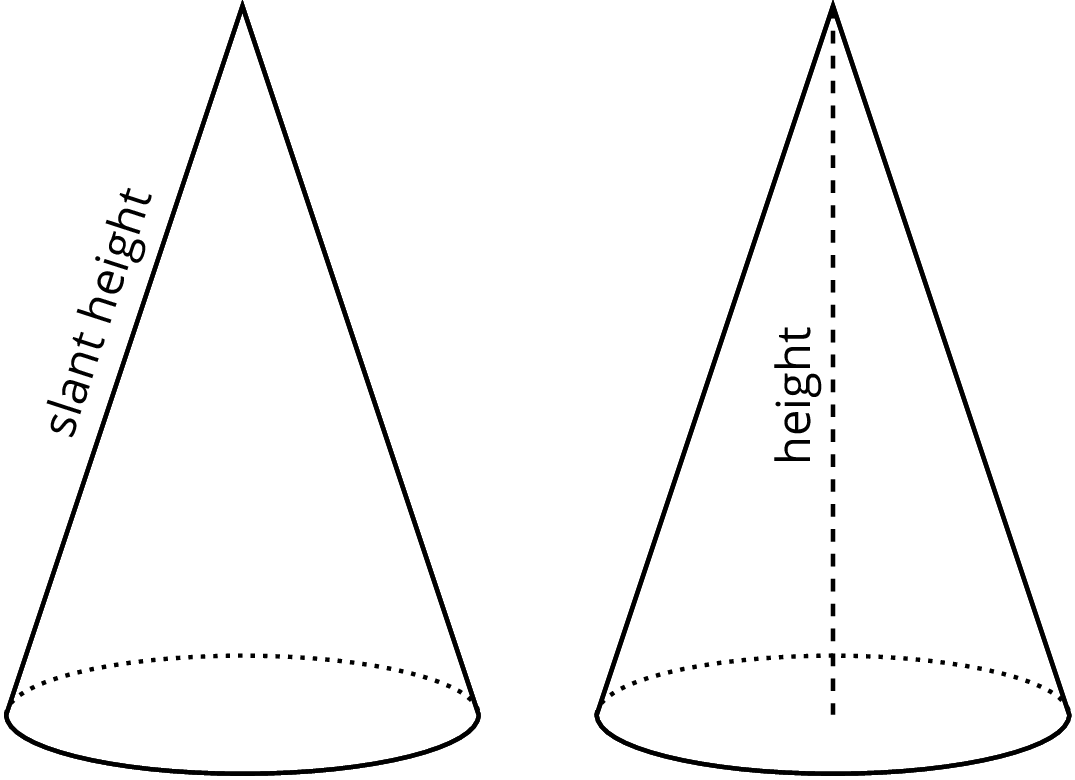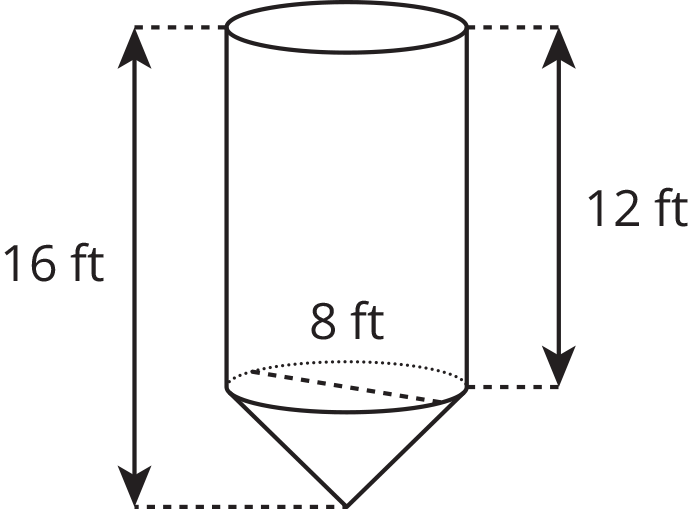Lesson 19
The Volume of a Cone
19.1: Which Has a Larger Volume? (5 minutes)
Warm-up
The purpose of this activity is for students to think about how the volume of a cone might relate to the volume of a cylinder with the same base and height. Additionally, students learn one method for sketching a cone. In this activity, just elicit students’ best guess about how many cone-contents would fit into the cylinder (or, what fraction of the cylinder’s volume is the cone’s volume). In the next activity, they will watch a demonstration that verifies the actual amount.
Launch
If you have access to appropriate geometric solids that include a cylinder and a cone with congruent bases and equal heights, consider showing these to students, even passing them around for students to hold if time permits.
Arrange students in groups of 2. Give students 2–3 minutes of quiet work time, followed by time to discuss fractional amount with partner. Follow with a whole-class discussion.
Student Facing
The cone and cylinder have the same height, and the radii of their bases are equal.
- Which figure has a larger volume?
- Do you think the volume of the smaller one
is more or less than \(\frac12\) the volume of the
larger one? Explain your reasoning. - Sketch two different sized cones. The oval doesn’t have to be on the bottom! For each drawing, label the cone’s radius with \(r\) and height with \(h\).

Here is a method for quickly sketching a cone:

- Draw an oval.
- Draw a point centered above the oval.
- Connect the edges of the oval to the point.
- Which parts of your drawing would be hidden
behind the object? Make these parts dashed lines.
Student Response
For access, consult one of our IM Certified Partners.
Anticipated Misconceptions
If students think the two shapes will have the same volume, ask them to imagine dropping the cone into the cylinder and having extra space around the cone and still inside the cylinder.
Activity Synthesis
Invite students to share their answers to the first two questions. The next activity includes a video that shows that it takes 3 cones to fill a cylinder that has the same base and height as the cone, so it is not necessary that students come to an agreement about the second question, just solicit student’s best guesses, and tell them that we will find out the actual fractional amount in the next activity.
End the discussion by selecting 2–3 students to share their sketches. Display these for all to see and compare the different heights and radii. If no student draws a perpendicular height or slant height, display the image shown here for all to see and remind students that in earlier units we learned that height creates a right angle with something in the figure. In the case of the cones, the height is perpendicular to the circular base.

19.2: From Cylinders to Cones (20 minutes)
Activity
In this activity, students use the relationship that the volume of a cone is \(\frac13\) of the volume of a cylinder to calculate the volume of various cones. Students start by watching a video (or demonstration) that shows that it takes the contents of 3 cones to fill the cylinder when they have congruent bases and equal heights. Students use this information to calculate the volume of various cones and cylinders. For the last question, identify students who:
- write the equation as \(\frac13 V\) (or \(V \div 3\)), where \(V\) represents the volume of a cylinder with the same base and height as the cone.
- write the equation in terms of \(r\) and \(h\) (\(V=\frac13\pi r^2h\) ).
Launch
Either conduct a demonstration or show the video and tell students to write down anything they notice or wonder while watching. Pause for a whole-class discussion. Record what students noticed and wondered for all to see. Ensure that students notice that it takes the contents of 3 cones to fill the cylinder, or alternatively, that the volume of the cone is \(\frac13\) the volume of the cylinder. Then, set students to work on the questions in the task, followed by a whole-class discussion.
Design Principle(s): Support sense-making; Optimize output (for explanation)
Student Facing
A cone and cylinder have the same height and their bases are congruent circles.
- If the volume of the cylinder is 90 cm3, what is the volume of the cone?
- If the volume of the cone is 120 cm3, what is the volume of the cylinder?
- If the volume of the cylinder is \(V=\pi r^2h\), what is the volume of the cone? Either write an expression for the cone or explain the relationship in words.

Student Response
For access, consult one of our IM Certified Partners.
Activity Synthesis
Select previously identified students to share the volume equation they wrote for the last question. Display examples for all to see and ask “Are these equations the same? How can you know for sure?” (The calculated volume is the same when you use both equations.)
If no student suggests it, connect \(\frac13 V\), where \(V\) represents the volume of a cylinder with the same base and height as the cone, to the volume of the cone, \(\frac13\pi r^2h\). Reinforce that these are equivalent expressions.
Add the formula \(V=\frac13\pi r^2h\) and a diagram of a cone to your classroom displays of the formulas being developed in this unit.
19.3: Calculate That Cone (10 minutes)
Activity
The purpose of this activity is for students to calculate the volume of cones given their height and radius. Students are given a cylinder with the same height and radius and use the volume relationship they learned in the previous activity to calculate the volume of the cone. They then calculate the volume of a cone given a height and radius using the newly learned formula for volume of a cone. For the last problem, an image is not provided to give students the opportunity to sketch one if they need it.
Launch
Give students 3–5 minutes of quiet work time followed by a whole-class discussion.
Student Facing
- Here is a cylinder and cone that have the same height and the same base area.
What is the volume of each figure? Express your answers in terms of \(\pi\).

- Here is a cone.
- What is the area of the base? Express your answer in terms of \(\pi\).
- What is the volume of the cone? Express your answer in terms of \(\pi\).

- A cone-shaped popcorn cup has a radius of 5 centimeters and a height of 9 centimeters. How many cubic centimeters of popcorn can the cup hold? Use 3.14 as an approximation for \(\pi\), and give a numerical answer.
Student Response
For access, consult one of our IM Certified Partners.
Student Facing
Are you ready for more?
A grain silo has a cone shaped spout on the bottom in order to regulate the flow of grain out of the silo. The diameter of the silo is 8 feet. The height of the cylindrical part of the silo above the cone spout is 12 feet while the height of the entire silo is 16 feet.
How many cubic feet of grain are held in the cone spout of the silo? How many cubic feet of grain can the entire silo hold?

Student Response
For access, consult one of our IM Certified Partners.
Anticipated Misconceptions
In the first problem, students might use 10 as the radius length. Ask students what the length of 10 in the picture is called. Ask students to recall the formula for the volume of a cylinder.
For students who are not sure where to begin the last problem since it does not have an image, encourage them to sketch and label their own.
Activity Synthesis
For the first problem, Invite students to explain how they calculated the volume of both figures and have them share the different strategies they used. If not mentioned by students bring up these strategies:
- Calculate the volume of the cylinder, then divide volume of cylinder by 3 to get the volume of the cone.
- Calculate the volume of the cylinder, then multiply volume of cylinder by \(\frac13\) to get the volume of the cone.
- Calculate the volume of the cone, then multiply volume of cone by 3 to get the volume of the cylinder.
For the third problem, ask students to share any sketches they came up with to help them calculate the answer. Explain to students that sometimes we encounter problems that don’t have a visual example and only a written description. By using sketches to help to visualize what is being described in a problem, we can better understand what is being asked.
Supports accessibility for: Language; Social-emotional skills; Attention
Design Principle(s): Maximize meta-awareness
Lesson Synthesis
Lesson Synthesis
Have students summarize the highlights of the lesson by asking:
- “What is the relationship between the volume of a cylinder and the volume of a cone?” (The volume of a cone is \(\frac13\) of the volume of a cylinder or the volume of the cylinder is 3 times the volume of the cone.)
- “If we know the volume of a cone, how do we calculate the volume of a cylinder that has the same height and base area?” (We can multiply the volume of the cone by 3.)
- “If we know the volume of a cylinder, how do we calculate the volume of a cone that has the same height and base area?” (We can multiply the volume of the cylinder by \(\frac13\).)
- “If a cylinder and a cone have the same base, how tall does the cone have to be relative to the cylinder so that they both have the same volume?” (The cone needs to have a height 3 times the height of the cylinder for the two shapes to have the same volume.)
19.4: Cool-down - Calculate Volumes of Two Figures (5 minutes)
Cool-Down
For access, consult one of our IM Certified Partners.
Student Lesson Summary
Student Facing
If a cone and a cylinder have the same base and the same height, then the volume of the cone is \(\frac{1}{3}\) of the volume of the cylinder. For example, the cylinder and cone shown here both have a base with radius 3 feet and a height of 7 feet.
The cylinder has a volume of \(63\pi\) cubic feet since \(\pi \boldcdot 3^2 \boldcdot 7 = 63\pi\). The cone has a volume that is \(\frac13\) of that, or \(21\pi\) cubic feet.

If the radius for both is \(r\) and the height for both is \(h\), then the volume of the cylinder is \(\pi r^2h\). That means that the volume, \(V\), of the cone is \(\displaystyle V=\frac{1}{3}\pi r^2h\)